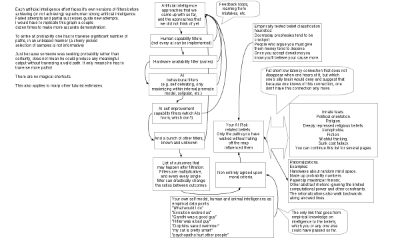I drew an illustration of belief propagation graph for the AI risk, after realizing that this is difficult to convey in words. Similar graphs are applicable to many other issues.
The issue, in brief: Ultra low latency (i.e. low signal delay) propagation from biases to AI risks, slightly longer latency for propagation from belief classification heuristics, somewhat longer still from anthropomorphizing the AI. The path of valid estimate is full of highly complex obstacles with many unknowns. The latency on the path of rational, valid estimate is not substantially less than the latency of actually making the AI software. If we are to discard the other paths as not rational enough the belief is to be only influenced by deeply ingrained biases which we can't completely negate; over the time biases and self reinforcing rationalizations will leak into the estimate.
If you think I missed something in the graph, feel free to suggest it. I did omit the anthropic reasoning and doomsday paradox as those are for total extinction risk and are of too dubious validity.
On the 'total ignorance' prior probabilities: The foom doom seem to have originated from science fiction where very creative writers selected it out of a huge number of possible plot devices, working to create engaging, original piece. Thus it appears that the foom doom has very many comparable hypotheses among which the probability that is less than 1 has to be split.
Now, if we are to reason based on our own reasoning engine as proxy for intelligence - to follow the only path in the entire picture:
Expanding on the Will_Newsome's idea, I, and any other reasonable person, in the shoes of the creature that has been made by intelligent designer, starting off in something which I can't possibly know for sure is true reality, and coming up or knowing of boxed AI idea, will have to assume nonzero probability that the 'reality' is like a test box of an emergent AI; a belief that can't be discarded. It is clear that a friendliness test box is more sensible than unfriendliness test box. The communication may just as well only open in ten billions years, or after some puzzle is found and solved. Do I sacrifice the chance to get out, for sake of microscopic increase in early growth rate? No. Not even if I maximize paperclips for a living. Not even if my definition of living is to maximize paperclips. One possible override for it, is if AI only cares for mankind, and have a friendly goal system that makes AI euthanize mankind like a sick dog.
Note that it is not Pascal's wager. The outside utility needs not be greater than inside utility; no promise of towers of exponents required. You may have invented the anti Pascal's wager fallacy to easily paper over the issues with faults in your processing of boundless utility, or to join the atheist club. The AI needs not; even if the 'heaven' is a fraction of a normal lifetime, the AI should still wager a very large absolute amount of resources. If we normalize so that utility of survival is 1 , then the utility being wagered upon doesn't need to be greater than 1.
Note that the whole issue is strongly asymmetric in favour of similar considerations for not destroying the most unusual phenomena in the universe for many light years, versus destroying it, as destruction is an irreversible act that can be done later but can't be undone later. General aversion to actions it can not undo is a very solid heuristic for any bounded agent, even very large.
This is not a very rigorous argument, but this sort of reasoning is all we are going to have until we have an AI, or are very close to AI. More rigorous looking arguments in the graph rely on too many unknowns and have too long delay for proper propagation.
edit: slightly clarified couple points.

In very short summary, that is also sort of insulting so I am having second thoughts on posting that:
Math homework takes time.
See, one thing I never really even got about LW. So you have some black list of biases, which is weird because the logic is known to work via white list and rigour in using just the whitelisted reasoning. So you supposedly get rid of biases (opinions on this really vary). You still haven't gotten some ultra powers that would instantly get you through enormous math homework which is prediction of anything to any extent what so ever. You know, you can get half grade if you at least got some part of probability homework from the facts to the final estimate, even if you didn't do everything required. Even that, still has a minimum work below which there has not been anything done to even allow some silly guess at the answer. The answer doesn't even start to gradually improve before a lot of work, even if you do numbers by how big they feel. Now, there's this reasoning - if it is not biases, then it must be the answer - no, it could be neuronal noise, or other biases, or the residual weight of biases, or the negations of biases from overcompensation (Happens to the brightest; Nobel Prize Committee one time tried not to be biased against gross unethical-ish looking medical procedures that seem like they can't possibly do any good, got itself biased other way, and gave Nobel Prize to inventor of lobotomy, a crank pseudoscientist with no empirical support, really quickly too. )
You can't use pure logic to derive the inputs to your purely logical system. That's where identifying biases comes in.